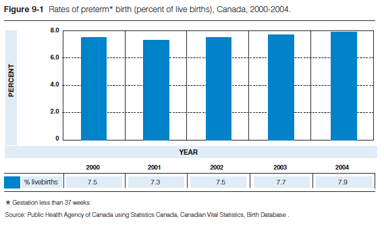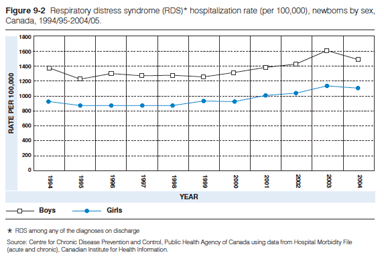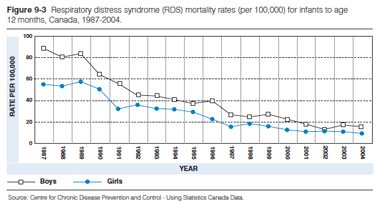Respiratory Distress Syndrome
Introduction
Respiratory Distress Syndrome (RDS), also known as hyaline membrane disease, is a condition associated with severe breathing difficulty seen predominantly in premature infants. RDS is caused by a primary deficiency of surfactant, a substance that coats the alveoli (air sacs) in healthy lungs and prevents them from collapsing during exhalation.1 As a result of this deficiency, the baby cannot take up enough oxygen.
The maturation of a baby's surfactant system occurs gradually in the third trimester of pregnancy. The point at which the system is sufficiently mature for RDS not to occur varies widely from one baby to another. In most infants the system is mature by about 36 weeks of gestation, but RDS can occur in full-term babies, particularly if the mother is diabetic. Conversely, a few infants of less than 30 weeks’ gestation may already have a mature surfactant system.
In its acute phase RDS commonly leads to significant complications. These include bronchopulmonary dysplasia, a chronic respiratory problem secondary to the effect of inflammation on the immature lung.2 This may lead to prolonged hospitalization and significant post-discharge dependence on technology to assist with breathing. Babies with severe RDS may also develop other neurological complications that are commonly associated with prematurity, such as intraventricular bleeding and periventricular leukomalacia. These complications severely affect the child's development. Babies with RDS are also more likely to be diagnosed and hospitalized with asthma between the ages of 1 and 4 years.3
The prognosis for RDS has improved significantly over the last 30 years.4 The introduction in the 1980s of antenatal steroids that increase surfactant production in the fetus has contributed to this trend. In addition, the availability of a variety of surfactant treatments, which have been shown to be highly effective in decreasing morbidity and mortality, has improved the prognosis for babies who develop RDS.5
Risk Factors and Prevention
Reducing premature birth is the most effective preventive method against RDS, but the rate of preterm birth in Canada increased slightly between 2000 and 2004 (Figure 9-1). The exact cause for this increase is unknown, but a contributing factor is the increase in multiple births (birth of more than one infant from one pregnancy).6 Part of this trend is the increased use of assisted reproductive technologies, which often result in pregnancies with more than one baby. In addition, a higher proportion of births are among older women, who have a higher risk of multiple birth.
Many hypotheses exist to explain the causes of preterm labour, but the underlying cause is often unknown. Nonetheless, some risk factors have been identified, including cigarette smoking, stress, vaginal infection, multiple birth, being under age 20 or over age 35, and inadequate nutrition and weight gain in pregnancy.7
Even if preterm birth cannot be prevented, the administration of a very short course (two doses 24 hours apart) of antenatal steroids to the mother has been shown to be highly effective in decreasing the severity and incidence of RDS.8 Antenatal steroids also decrease the incidence of other important complications of prematurity, including intraventricular hemorrhage and bronchopulmonary dysplasia. According to the Canadian Neonatal Network database, 31.8% of infants under 35 weeks gestation received a complete course of antenatal steroids in 2005; 34.6% received a partial course and 28.5% received no steroids. In 5% of cases, it was unknown whether steroids were used.9
Incidence/Prevalence
In the pre-steroid era, RDS was seen in at least 50% of infants weighing between 1,000 and 1,500 g; this figure decreased to 5% in infants between 2,000 and 2,500 g.10 The use of antenatal steroids has reduced these numbers.11
In spite of the advances gained by antenatal steroid use, the risk of RDS remains a reality. Although 66% of infants under 35 weeks gestation received antenatal steroids in 2005,12 87% of infants weighing less than 1,500 g still required a period of assisted ventilation,13 and 44% of infants less than 1,500 g still required treatment with surfactant.14
Hospitalization
Since most babies are born in hospital, hospitalization rates can give a fairly accurate indication of the incidence of RDS.
The hospitalization rates for RDS for both boys and girls remained relatively constant from 1994 to 2000. Since then, there has been a slight increase in both sexes (Figure 9-2). The ratio of hospitalizations for RDS among newborn boys to girls in 2004 was 1.4:1.
RDS requires the expenditure of major health financial resources. The need for assisted ventilation comprises one of the major costs of the care of premature infants. Data from the Canadian Neonatal Network reveal that in 2005 infants of less than 750 g spent an average of 31.6 days on assisted ventilation. Babies weighing between 1,500 and 2,500 g spent less than one day.15 The average hospital costs in 2002–03 were $117,806 per newborn weighing less than 750 g.16
Mortality
Although there have been significant advances in prevention and treatment of RDS the last two decades, this condition remains the major cause of death in babies born prematurely.17
Mortality rates from RDS for infants under 1 year old declined steadily between 1987 and 2004. Rates for boys continued to be higher than for girls (Figure 9-3).
Antenatal steroid use and surfactant treatments have contributed to increased survival rates among preterm babies. While the mortality rate for infants weighing 1,000 to 1,500 g was reported as 66% in 1961,18 it is now less than 4%. Even for babies of less than 750 g, who rarely survived in 1961, survival is now greater than 52%.19
Discussion and Implications
RDS is a serious condition that primarily affects prematurely born infants. It has a major impact on the health of the child, induces great stress on the family and requires a considerable expenditure of health care resources.
While the decrease in mortality rates does attest to the success of treatment in the modern neonatal intensive care unit, further improvements in neonatal health will require the prevention of preterm birth, the underlying cause of RDS. Unfortunately, the incidence of preterm births is increasing rather than decreasing.
Prevention of preterm birth calls for the enforcement of guidelines governing the use of assisted reproductive technologies to decrease multiple births. The recently established Assisted Human Reproduction Canada will be implementing the Assisted Human Reproduction Act. This legislation will contribute to ensuring the health and safety of women using assisted reproductive technologies and the children born of them. Preventing preterm birth also involves education and supportive public policies to promote healthy lifestyles among all pregnant women. Continued research into the causes of preterm birth aims to provide the basis for effective prevention programs.
Population-based approaches to ensure early intervention and effective management are urgently required to reduce the risk of RDS when preterm birth occurs. Widespread adoption of antenatal steroids for threatened preterm delivery has significantly improved the prognosis for RDS. Despite the known benefits of these steroids, however, many preterm babies still do not receive them. Since the steroids must be started 48 hours prior to birth if they are to be of optimal benefit, it is essential for women to come to the hospital as soon as preterm labour starts.Drugs to stop preterm labour can delay birth long enough to administer antenatal steroids.20 Therefore, all women must know the signs and symptoms of preterm labour, and health care providers must be ready to respond appropriately.
Adequate surveillance data would improve our understanding of RDS at the population level. Most current information on RDS comes from single-or multiple-centre databases and clinical trials. No systematic approach currently exists for the timely and universal collection of data. Comprehensive population-based data on the incidence and outcome of preterm births and RDS would greatly facilitate the development of research and preventive strategies.
1 Avery ME, Mead J. Surface properties in relation to atelectasis and hyaline membrane disease. Am J Dis Child 1959; 97:517-23.
2 Abbasi S, Bhutani VK, Gerdes JS. Long-term pulmonary consequences of respiratory distress syndrome in preterm infants treated with exogenous surfactant. J Pediatr 1993;122:446-52.
3 Shaubel D et al. Neonatal characteristics as risk factors for preschool asthma. J Asthma 1996;33(4):255-64.
4 Richardson DK, Gray JE, Gortmaker SL, Goldmann DA, Pursley DM, McCormick MC. Declining severity adjusted mortality: Evidence of improving neonatal intensive care. Pediatrics 1998;102:893-99.
5 Fujiwara T, Chida S, Watabe Y, Maeta H, Morita T, Abe T. Artificial surfactant therapy in hyaline membrane disease. Lancet 1980;i:55-9.
6 Preterm birth: making a difference. [Ottawa:] Best Start Resource Centre in collaboration with the Perinatal Partnership program of Eastern and Southeastern Ontario and the Society of Obstetricians and Gynaecologists of Canada; 2002. p. 5. Available from http://www.beststart.org/resources/rep_health/index.html
7 Preterm birth: making a difference. pp. 5-6.
8 Liggins GC, Howie RN. A controlled trial of antepartum glucocorticoid treatment for prevention of the respiratory distress syndrome in premature infants. Pediatrics 1972;50:515-25.
9 Canadian Neonatal Network. Annual Report 2005. p. 81. Available from: http://www.canadianneonatalnetwork.org/annual.shtml
10 Usher R. The respiratory distress syndrome of prematurity. Pediatr Clin of North Am 1961;8:525-38
11 Lee KS, Khoshnood B, Wall N, Chang YP, Hsieh HL, Singh JK. Trend in mortality from respiratory distress syndrome in the United States, 1970-1995. J Pediatr 1999;134:434-40.
12 Canadian Neonatal Network. Annual Report 2005. p. 81. Available from: http://www.canadianneonatalnetwork.org/annual.shtml
13 Calculated from: Canadian Neonatal Network. Annual Report 2005. p. 12, 56. Available from: http://www.canadianneonatalnetwork.org/annual.shtml
14 Personal Communication/Custom tabulation: Aireen Wingert. Canadian Neonatal Network. July 27, 2007.
15 Canadian Neonatal Network. Annual Report 2005. p. 54. Available from: http://www.canadianneonatalnetwork.org/annual.shtml
16 Canadian Institute for Health Information. Giving Birth in Canada: The Costs. Ottawa: The Institute; 2006. p. 30, Figure 14.
17 Stevenson DK, Wright LL, Lemons JA, Oh W, Korones SB, Papile LA, et al. Very low birth weight outcomes of the National Institute of Child Health and Human Development Neonatal Research Network, January 1993 through December 1994. Am J Obstet Gynecol 1998;179:1632-39.
18 Lee KS, Khoshnood B, et al.
19 Canadian Neonatal Network. Annual Report 2005. p. 74. Available from: http://www.canadianneonatalnetwork.org/annual.shtml



